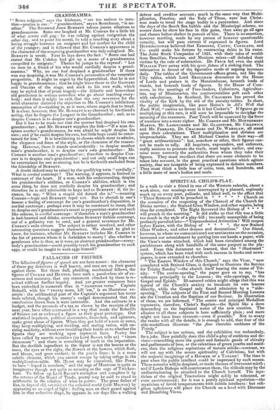SPIRITUAL CHILD'S-PLAY.
IN a walk to visit a friend in one of the Western suburbs, about a week since, our musings were interrupted by a placard, copiously stuck up on every post, palisade and blind wall, to the effect that "Three Sermons will be preached in * • * * * Church on the occasion of the reopening of the Chancel of the Church for Divine service ; the Stained Glass Window, and other repairs, being thus far completed. The Right Reverend the Bishop of • • * * will preach in the morning." It did strike us that this was a little too much in the style of a play-bill ; too easily susceptible of being profanely parodied into—" Unprecedented Attraction ! Will reopen before Easter, with the Bishop of * * * *, the new Stained Glass Window, and other dresses and decorations." Our friend, however, to whom we communicated our sentiments on the occasion, increased our astonishment by putting into our hands a paper, with the Vicar's name attached, which had been circulated among the parishioners along with handbills of the same purport as the pla- card. From this document we learned, that the " illustrated " system, which has been tried with such success in books and news- papers, is now extended to churches. "The Eastern Window of this Church," says the Vicar, "now completed with Stained Glass, is designed to illustrate the Service for Trinity Sunday"—the church itself bearing the name of Tri- nity. "The centre-opening," the paper goes on to say, "has reference principally to the Lessons ; the side-openings, to the Gospel and Epistle." Ill-natured critics might allege that this was typical of the Church's anxiety to inculcate its own lessons directly, while the Gospel only found admission by a "side- opening." The subjects of the First and Second Morning Lessons are the Creation and the Baptism of our Saviour. In illustration of these, we are informed, "The centre and principal Medallion represents, therefore, Christ's Baptism—the Spirit like a dove descending on the baptismal water of the new creation. The allusion to all these subjects is here sufficiently plain ; and more might not have been reverent—even if possible." Not to weary the reader with all the details, it is enough to add, that four of the side-medallions illustrate "the four cherubic emblems of the Trinity." The subject is too serious, and the exhibition too melancholy, for a joke. How painfully does this child's-play of emblems and de- vices—resembling more the quaint and fantastic gauds of chivalry and parliaments of love, or the valentines of green youths and maid- ens, than the religious aspirations of mature minds—contrast, we will not say with the severe spirituality of Calvinism, but with the majestic imaginings of a HOOKER or a TAYLOR! The time is past when the public intellect could be impressed by such means. These conceits wilkbe despised, or made themes of irreverent mirth ; and if Lords Bishops will countenance them, the ridicule may by the undiscriminating be attached to the Church herself. The mys- ticism of the original Tractarians might safely be tolerated, or even countenanced ; for it was a purely spiritual mysticism—the mysticism of fervid temperaments with subtile intellects : but reli- gious upholstery will place the Church on a level with Dioramas and Dissolving Views.


















































 Previous page
Previous page